A SOUTHERN TREAT
A Good Site
Okra, like artichokes and dark beer, evokes from people either praise or disgust, rarely something in between. A pot of stewed okra, tomatoes, and onions sends me into creole heaven, yet makes my brother gag. I say the mucilaginous quality of okra adds “body” to a dish; he says okra is “slimy.”
This season I’m reveling in a bumper crop of okra. Such a crop would hardly be worth noting if I gardened south of the Mason-Dixon line, where okra plants grow to be the size of small trees! Growing okra up here in the Hudson Valley is somewhat of a challenge because the plants begin to shiver when temperatures drop into the 50s — not uncommon even for a midsummer night in my garden.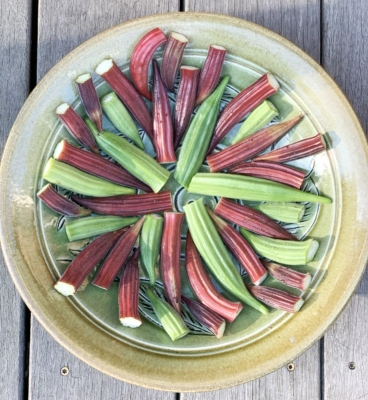
In spite of a good bit of hot weather this summer (1.3°F above the 127 year average), I like to think I had a hand in this season’s success with okra. And the first okra-righteous thing I did was to choose for my planting a good site: the hottest and sunniest spot in my garden.
Lack of sunlight used to be a problem when my garden beds ran east and west; tall plants, such as popcorn, on ann adjacent bed to the south of the okra bed would shade the okra. A couple of years ago I re-oriented my beds north to south — a job unfortunately much harder than just flicking them ninety degrees. Anyway, that job is now history. No neighboring plants, trees, or structures now shade that okra from sunrise until mid to late afternoon.
Growing Details
In past years, my okra plants always came up slowly and sparsely. Because the seeds germinate poorly below 70 degrees Fahrenheit, this year I waited until the soil was well warmed — at the very end of May — to plant. But even then, I didn’t just dribble the seeds into a furrow. Okra has a hard seed coat, so I first soaked the seeds indoors overnight, then drained the water, but kept the seeds moist until little white rootlets poked through the seed coats. After a few days, I planted the sprouting seeds into the waiting, warm soil.
Once seedlings were up and looking strong, I thinned them to prevent overcrowding. Actually, I thinned them twice, the first time to maximize early harvest, then later to allow each plant more room in which to spread its leaves.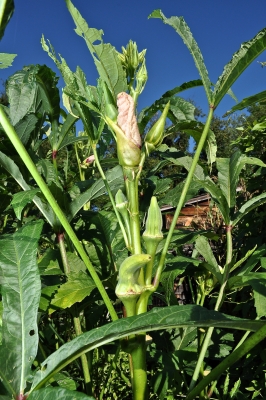
I’ve never been able to bring myself to thin okra plants to the recommended spacing of one to two feet apart in the rows, because each plant seems too valuable to sacrifice so ruthlessly. (I usually run two rows of okra down my three foot wide beds, with rows two feet apart.) That thinning to one to two feet in the rows seemed more suited to the okra “trees” that grow down South. Once I’ve reaped a few harvests, I do a final thinning to about six inch spacing the rows.
My beds now are watered automatically with drip irrigation. Before I had drip, I wouldn’t ever water the plants. Benign neglect seemed to help. Conditions are a lot drier in their native home of Ethiopia and the Upper Nile! Okra has deep roots and the plants never wilted.
I did mulch the plants once the ground had thoroughly warmed in July, and this, no doubt, helped the plants weather dry spells.
On the other hand, the okra plants danced though this summer’s record rainfall, 7.5” above the 127 year average, bearing well. And there were rainy spells during which I even forgot to turn off the drip irrigation!
(My weather data comes courtesy of the Mohonk Preserve weather station, which is nearby, but 1000 feet higher than, my farmden.)
A Variety of Tasty Beauties
I’ve tried a lot of varieties of okra, including Cajun Jewel, Beck’s Big Buck, Heavy Hitter, Okinawa Pink, as well as the more familiar Clemson Spineless. Some varieties have grown to five feet tall by the end of the growing season, others top out at three foot height, some are green, and some are red.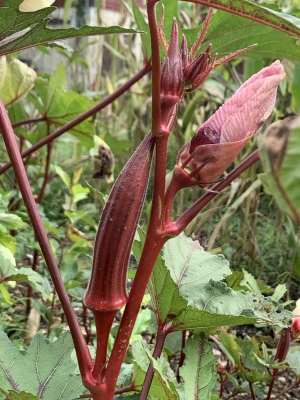
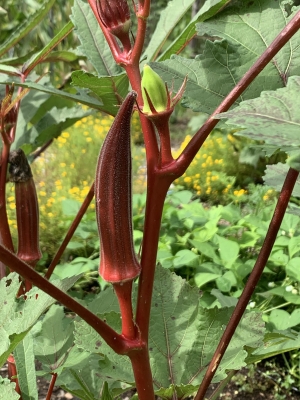
Interesting, red okra with green pod developing
I haven’t kept careful records of yields, but all seem to grow and bear reasonably well. And all bear cheery, pale yellow flowers with red centers, showing off, if you look closer, their kinship in the hibiscus family, along with cotton, rose of Sharon, marsh mallow (the original source for marshmallows), and, of course, the ornamental, tropical and hardy hibiscuses.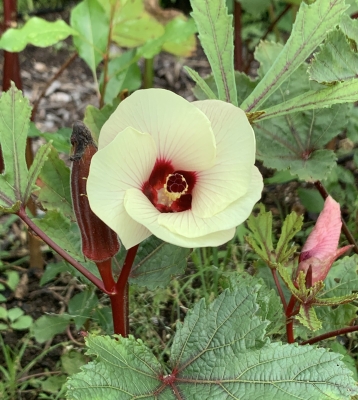
Once the weather warms and okra is growing vigorously, the most important thing is to remember to visit the plants every other day or so to pick the pods. If pods are left on the plants to mature, production of new pods slows down. Right now, with imminent cool weather, the race is on to fill the freezer and our bellies with as much okra as possible.
I do declare, I must have some southern blood in me.



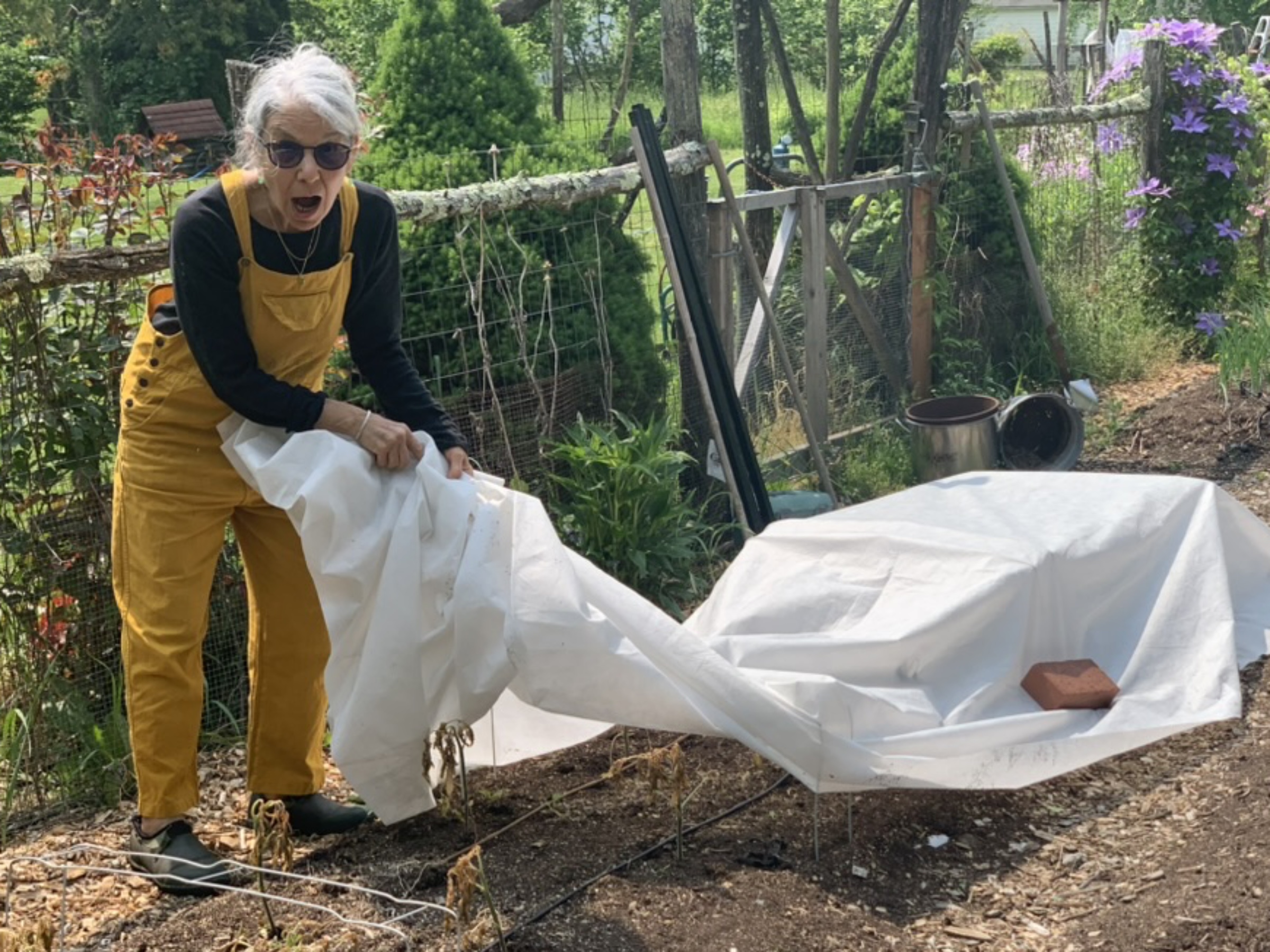
I’m so glad that you wrote about okra! I live in the upper Fingerlakes, but was inspired to grow okra by my annual trips to perform down in New Orleans. Now I grow it up here every year…not just for its incredible hibiscus-y beauty, but I’ve also come up with some fun recipes. For the last few years I had tree plants claiming all the garden attention, but this summer, only a meager size and harvest. I don’t know why, but I’m sure I won’t let it happen again. Enjoy your harvest!